Dissociative Identity Disorder and Psychosomatic Conditions
VerifiedAdded on 2023/03/29
|9
|2622
|81
AI Summary
This article explores the relationship between Dissociative Identity Disorder (DID) and psychosomatic conditions. It discusses the symptoms, diagnosis, and treatment of DID, as well as the connection between DID and psychosomatic disorders like depression. The article also examines the increase in DID diagnoses and the controversy surrounding its diagnosis. It concludes by highlighting the similarities and differences between DID and psychosomatic disorders.
Contribute Materials
Your contribution can guide someone’s learning journey. Share your
documents today.
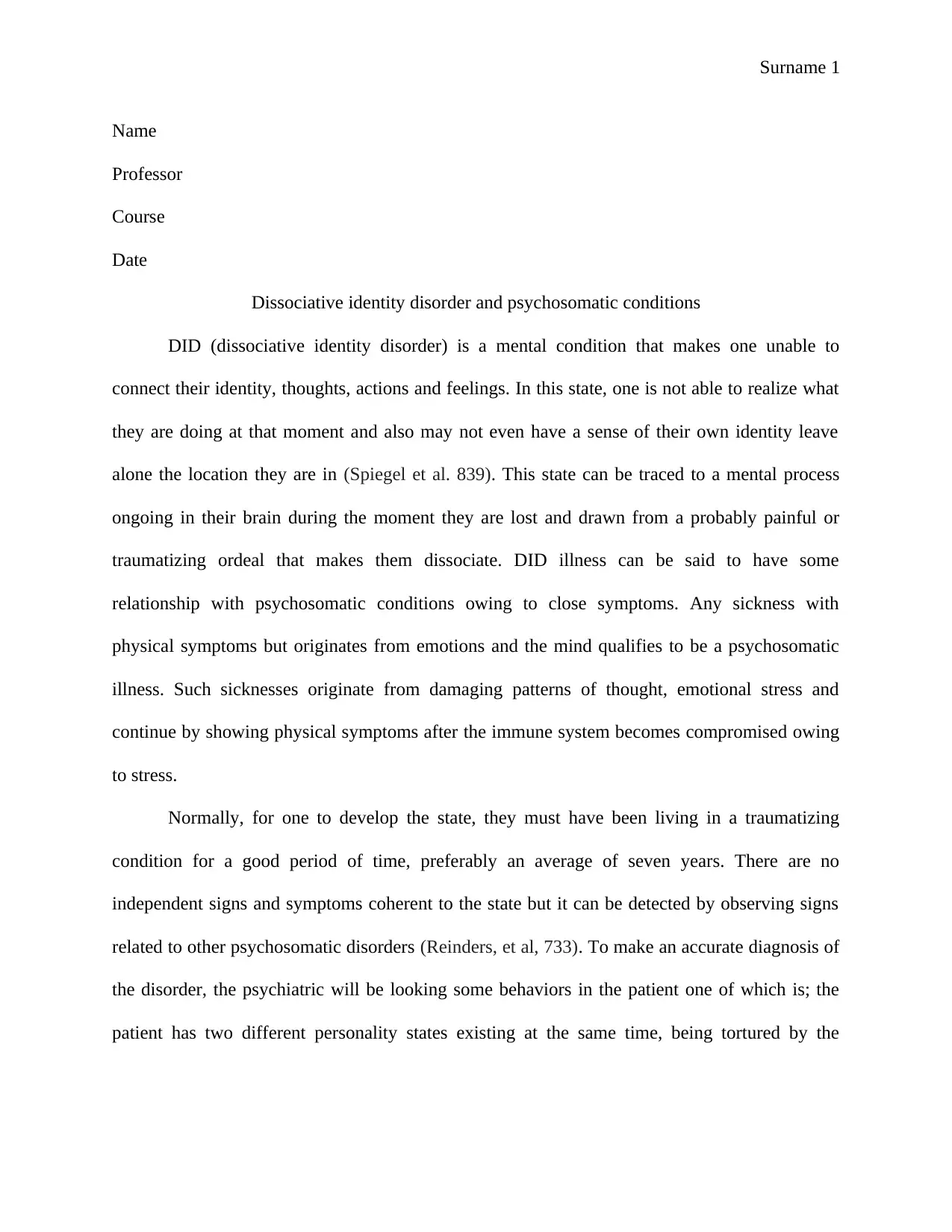
Surname 1
Name
Professor
Course
Date
Dissociative identity disorder and psychosomatic conditions
DID (dissociative identity disorder) is a mental condition that makes one unable to
connect their identity, thoughts, actions and feelings. In this state, one is not able to realize what
they are doing at that moment and also may not even have a sense of their own identity leave
alone the location they are in (Spiegel et al. 839). This state can be traced to a mental process
ongoing in their brain during the moment they are lost and drawn from a probably painful or
traumatizing ordeal that makes them dissociate. DID illness can be said to have some
relationship with psychosomatic conditions owing to close symptoms. Any sickness with
physical symptoms but originates from emotions and the mind qualifies to be a psychosomatic
illness. Such sicknesses originate from damaging patterns of thought, emotional stress and
continue by showing physical symptoms after the immune system becomes compromised owing
to stress.
Normally, for one to develop the state, they must have been living in a traumatizing
condition for a good period of time, preferably an average of seven years. There are no
independent signs and symptoms coherent to the state but it can be detected by observing signs
related to other psychosomatic disorders (Reinders, et al, 733). To make an accurate diagnosis of
the disorder, the psychiatric will be looking some behaviors in the patient one of which is; the
patient has two different personality states existing at the same time, being tortured by the
Name
Professor
Course
Date
Dissociative identity disorder and psychosomatic conditions
DID (dissociative identity disorder) is a mental condition that makes one unable to
connect their identity, thoughts, actions and feelings. In this state, one is not able to realize what
they are doing at that moment and also may not even have a sense of their own identity leave
alone the location they are in (Spiegel et al. 839). This state can be traced to a mental process
ongoing in their brain during the moment they are lost and drawn from a probably painful or
traumatizing ordeal that makes them dissociate. DID illness can be said to have some
relationship with psychosomatic conditions owing to close symptoms. Any sickness with
physical symptoms but originates from emotions and the mind qualifies to be a psychosomatic
illness. Such sicknesses originate from damaging patterns of thought, emotional stress and
continue by showing physical symptoms after the immune system becomes compromised owing
to stress.
Normally, for one to develop the state, they must have been living in a traumatizing
condition for a good period of time, preferably an average of seven years. There are no
independent signs and symptoms coherent to the state but it can be detected by observing signs
related to other psychosomatic disorders (Reinders, et al, 733). To make an accurate diagnosis of
the disorder, the psychiatric will be looking some behaviors in the patient one of which is; the
patient has two different personality states existing at the same time, being tortured by the
Secure Best Marks with AI Grader
Need help grading? Try our AI Grader for instant feedback on your assignments.
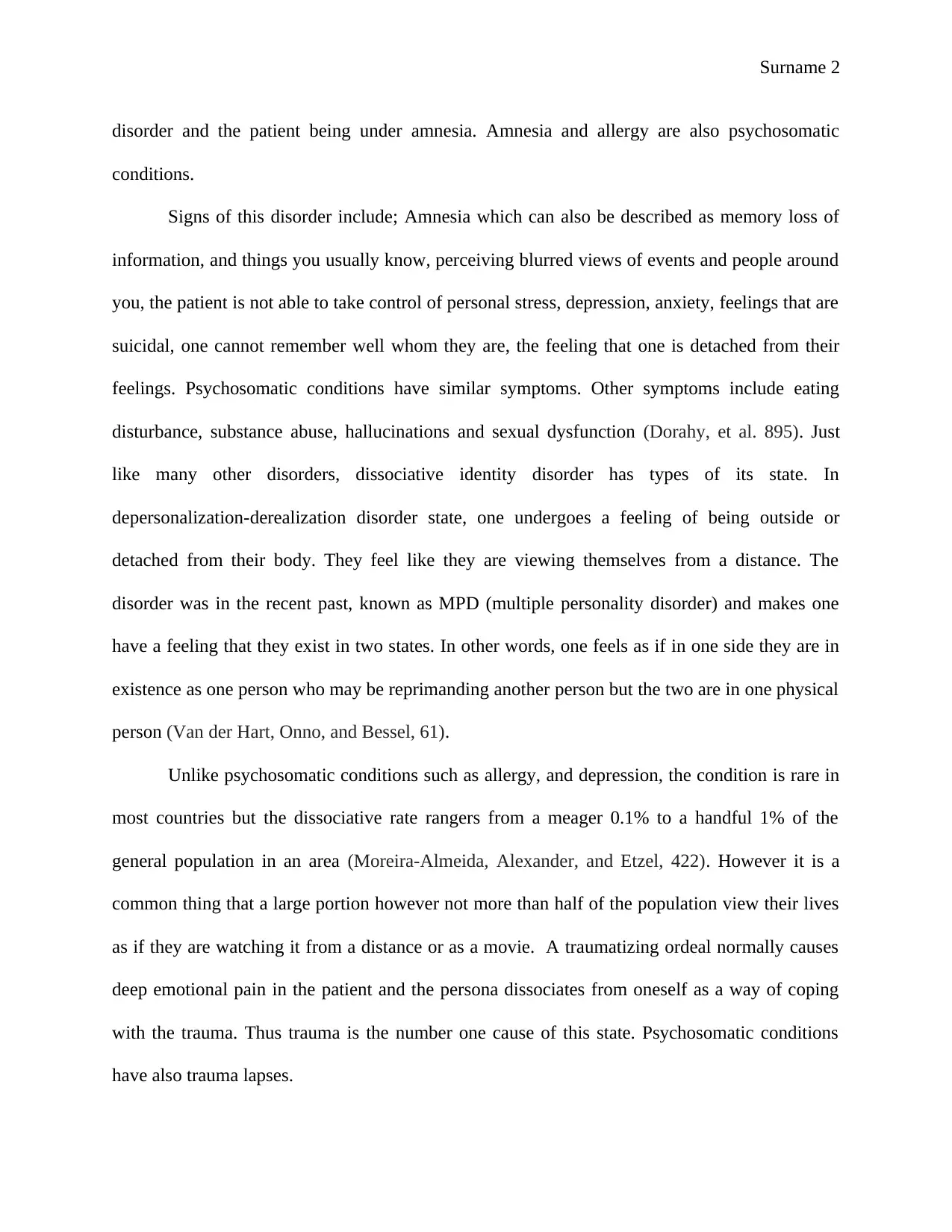
Surname 2
disorder and the patient being under amnesia. Amnesia and allergy are also psychosomatic
conditions.
Signs of this disorder include; Amnesia which can also be described as memory loss of
information, and things you usually know, perceiving blurred views of events and people around
you, the patient is not able to take control of personal stress, depression, anxiety, feelings that are
suicidal, one cannot remember well whom they are, the feeling that one is detached from their
feelings. Psychosomatic conditions have similar symptoms. Other symptoms include eating
disturbance, substance abuse, hallucinations and sexual dysfunction (Dorahy, et al. 895). Just
like many other disorders, dissociative identity disorder has types of its state. In
depersonalization-derealization disorder state, one undergoes a feeling of being outside or
detached from their body. They feel like they are viewing themselves from a distance. The
disorder was in the recent past, known as MPD (multiple personality disorder) and makes one
have a feeling that they exist in two states. In other words, one feels as if in one side they are in
existence as one person who may be reprimanding another person but the two are in one physical
person (Van der Hart, Onno, and Bessel, 61).
Unlike psychosomatic conditions such as allergy, and depression, the condition is rare in
most countries but the dissociative rate rangers from a meager 0.1% to a handful 1% of the
general population in an area (Moreira-Almeida, Alexander, and Etzel, 422). However it is a
common thing that a large portion however not more than half of the population view their lives
as if they are watching it from a distance or as a movie. A traumatizing ordeal normally causes
deep emotional pain in the patient and the persona dissociates from oneself as a way of coping
with the trauma. Thus trauma is the number one cause of this state. Psychosomatic conditions
have also trauma lapses.
disorder and the patient being under amnesia. Amnesia and allergy are also psychosomatic
conditions.
Signs of this disorder include; Amnesia which can also be described as memory loss of
information, and things you usually know, perceiving blurred views of events and people around
you, the patient is not able to take control of personal stress, depression, anxiety, feelings that are
suicidal, one cannot remember well whom they are, the feeling that one is detached from their
feelings. Psychosomatic conditions have similar symptoms. Other symptoms include eating
disturbance, substance abuse, hallucinations and sexual dysfunction (Dorahy, et al. 895). Just
like many other disorders, dissociative identity disorder has types of its state. In
depersonalization-derealization disorder state, one undergoes a feeling of being outside or
detached from their body. They feel like they are viewing themselves from a distance. The
disorder was in the recent past, known as MPD (multiple personality disorder) and makes one
have a feeling that they exist in two states. In other words, one feels as if in one side they are in
existence as one person who may be reprimanding another person but the two are in one physical
person (Van der Hart, Onno, and Bessel, 61).
Unlike psychosomatic conditions such as allergy, and depression, the condition is rare in
most countries but the dissociative rate rangers from a meager 0.1% to a handful 1% of the
general population in an area (Moreira-Almeida, Alexander, and Etzel, 422). However it is a
common thing that a large portion however not more than half of the population view their lives
as if they are watching it from a distance or as a movie. A traumatizing ordeal normally causes
deep emotional pain in the patient and the persona dissociates from oneself as a way of coping
with the trauma. Thus trauma is the number one cause of this state. Psychosomatic conditions
have also trauma lapses.
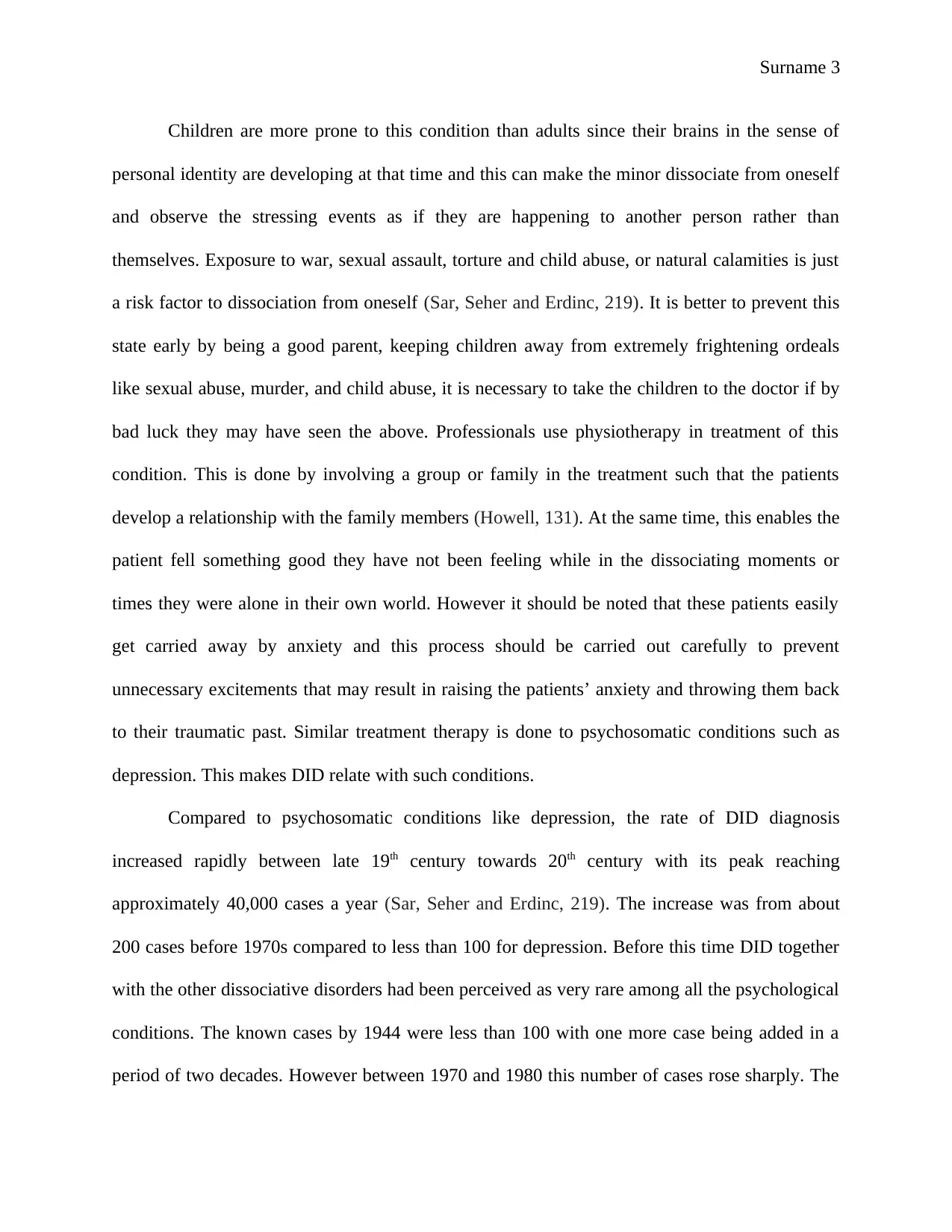
Surname 3
Children are more prone to this condition than adults since their brains in the sense of
personal identity are developing at that time and this can make the minor dissociate from oneself
and observe the stressing events as if they are happening to another person rather than
themselves. Exposure to war, sexual assault, torture and child abuse, or natural calamities is just
a risk factor to dissociation from oneself (Sar, Seher and Erdinc, 219). It is better to prevent this
state early by being a good parent, keeping children away from extremely frightening ordeals
like sexual abuse, murder, and child abuse, it is necessary to take the children to the doctor if by
bad luck they may have seen the above. Professionals use physiotherapy in treatment of this
condition. This is done by involving a group or family in the treatment such that the patients
develop a relationship with the family members (Howell, 131). At the same time, this enables the
patient fell something good they have not been feeling while in the dissociating moments or
times they were alone in their own world. However it should be noted that these patients easily
get carried away by anxiety and this process should be carried out carefully to prevent
unnecessary excitements that may result in raising the patients’ anxiety and throwing them back
to their traumatic past. Similar treatment therapy is done to psychosomatic conditions such as
depression. This makes DID relate with such conditions.
Compared to psychosomatic conditions like depression, the rate of DID diagnosis
increased rapidly between late 19th century towards 20th century with its peak reaching
approximately 40,000 cases a year (Sar, Seher and Erdinc, 219). The increase was from about
200 cases before 1970s compared to less than 100 for depression. Before this time DID together
with the other dissociative disorders had been perceived as very rare among all the psychological
conditions. The known cases by 1944 were less than 100 with one more case being added in a
period of two decades. However between 1970 and 1980 this number of cases rose sharply. The
Children are more prone to this condition than adults since their brains in the sense of
personal identity are developing at that time and this can make the minor dissociate from oneself
and observe the stressing events as if they are happening to another person rather than
themselves. Exposure to war, sexual assault, torture and child abuse, or natural calamities is just
a risk factor to dissociation from oneself (Sar, Seher and Erdinc, 219). It is better to prevent this
state early by being a good parent, keeping children away from extremely frightening ordeals
like sexual abuse, murder, and child abuse, it is necessary to take the children to the doctor if by
bad luck they may have seen the above. Professionals use physiotherapy in treatment of this
condition. This is done by involving a group or family in the treatment such that the patients
develop a relationship with the family members (Howell, 131). At the same time, this enables the
patient fell something good they have not been feeling while in the dissociating moments or
times they were alone in their own world. However it should be noted that these patients easily
get carried away by anxiety and this process should be carried out carefully to prevent
unnecessary excitements that may result in raising the patients’ anxiety and throwing them back
to their traumatic past. Similar treatment therapy is done to psychosomatic conditions such as
depression. This makes DID relate with such conditions.
Compared to psychosomatic conditions like depression, the rate of DID diagnosis
increased rapidly between late 19th century towards 20th century with its peak reaching
approximately 40,000 cases a year (Sar, Seher and Erdinc, 219). The increase was from about
200 cases before 1970s compared to less than 100 for depression. Before this time DID together
with the other dissociative disorders had been perceived as very rare among all the psychological
conditions. The known cases by 1944 were less than 100 with one more case being added in a
period of two decades. However between 1970 and 1980 this number of cases rose sharply. The
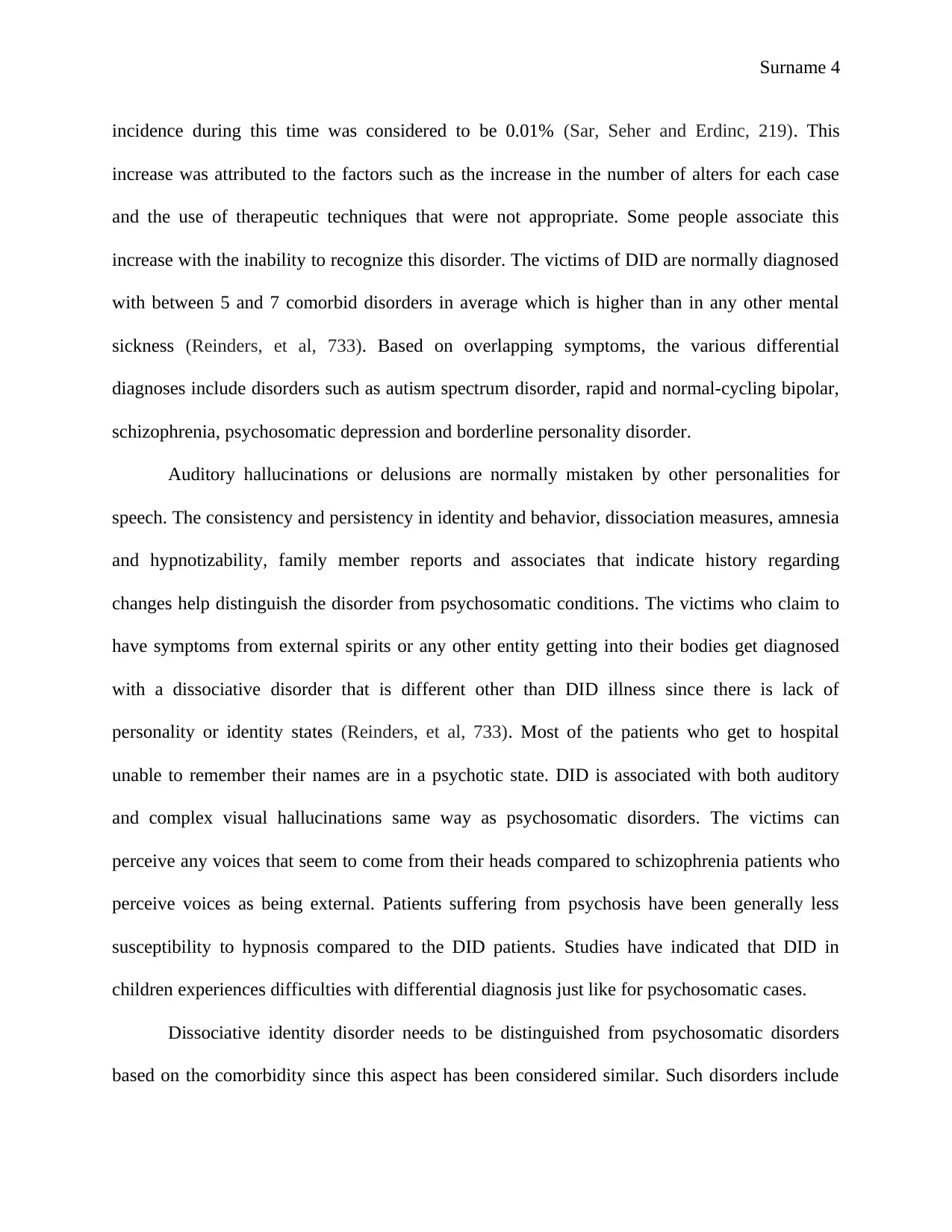
Surname 4
incidence during this time was considered to be 0.01% (Sar, Seher and Erdinc, 219). This
increase was attributed to the factors such as the increase in the number of alters for each case
and the use of therapeutic techniques that were not appropriate. Some people associate this
increase with the inability to recognize this disorder. The victims of DID are normally diagnosed
with between 5 and 7 comorbid disorders in average which is higher than in any other mental
sickness (Reinders, et al, 733). Based on overlapping symptoms, the various differential
diagnoses include disorders such as autism spectrum disorder, rapid and normal-cycling bipolar,
schizophrenia, psychosomatic depression and borderline personality disorder.
Auditory hallucinations or delusions are normally mistaken by other personalities for
speech. The consistency and persistency in identity and behavior, dissociation measures, amnesia
and hypnotizability, family member reports and associates that indicate history regarding
changes help distinguish the disorder from psychosomatic conditions. The victims who claim to
have symptoms from external spirits or any other entity getting into their bodies get diagnosed
with a dissociative disorder that is different other than DID illness since there is lack of
personality or identity states (Reinders, et al, 733). Most of the patients who get to hospital
unable to remember their names are in a psychotic state. DID is associated with both auditory
and complex visual hallucinations same way as psychosomatic disorders. The victims can
perceive any voices that seem to come from their heads compared to schizophrenia patients who
perceive voices as being external. Patients suffering from psychosis have been generally less
susceptibility to hypnosis compared to the DID patients. Studies have indicated that DID in
children experiences difficulties with differential diagnosis just like for psychosomatic cases.
Dissociative identity disorder needs to be distinguished from psychosomatic disorders
based on the comorbidity since this aspect has been considered similar. Such disorders include
incidence during this time was considered to be 0.01% (Sar, Seher and Erdinc, 219). This
increase was attributed to the factors such as the increase in the number of alters for each case
and the use of therapeutic techniques that were not appropriate. Some people associate this
increase with the inability to recognize this disorder. The victims of DID are normally diagnosed
with between 5 and 7 comorbid disorders in average which is higher than in any other mental
sickness (Reinders, et al, 733). Based on overlapping symptoms, the various differential
diagnoses include disorders such as autism spectrum disorder, rapid and normal-cycling bipolar,
schizophrenia, psychosomatic depression and borderline personality disorder.
Auditory hallucinations or delusions are normally mistaken by other personalities for
speech. The consistency and persistency in identity and behavior, dissociation measures, amnesia
and hypnotizability, family member reports and associates that indicate history regarding
changes help distinguish the disorder from psychosomatic conditions. The victims who claim to
have symptoms from external spirits or any other entity getting into their bodies get diagnosed
with a dissociative disorder that is different other than DID illness since there is lack of
personality or identity states (Reinders, et al, 733). Most of the patients who get to hospital
unable to remember their names are in a psychotic state. DID is associated with both auditory
and complex visual hallucinations same way as psychosomatic disorders. The victims can
perceive any voices that seem to come from their heads compared to schizophrenia patients who
perceive voices as being external. Patients suffering from psychosis have been generally less
susceptibility to hypnosis compared to the DID patients. Studies have indicated that DID in
children experiences difficulties with differential diagnosis just like for psychosomatic cases.
Dissociative identity disorder needs to be distinguished from psychosomatic disorders
based on the comorbidity since this aspect has been considered similar. Such disorders include
Secure Best Marks with AI Grader
Need help grading? Try our AI Grader for instant feedback on your assignments.
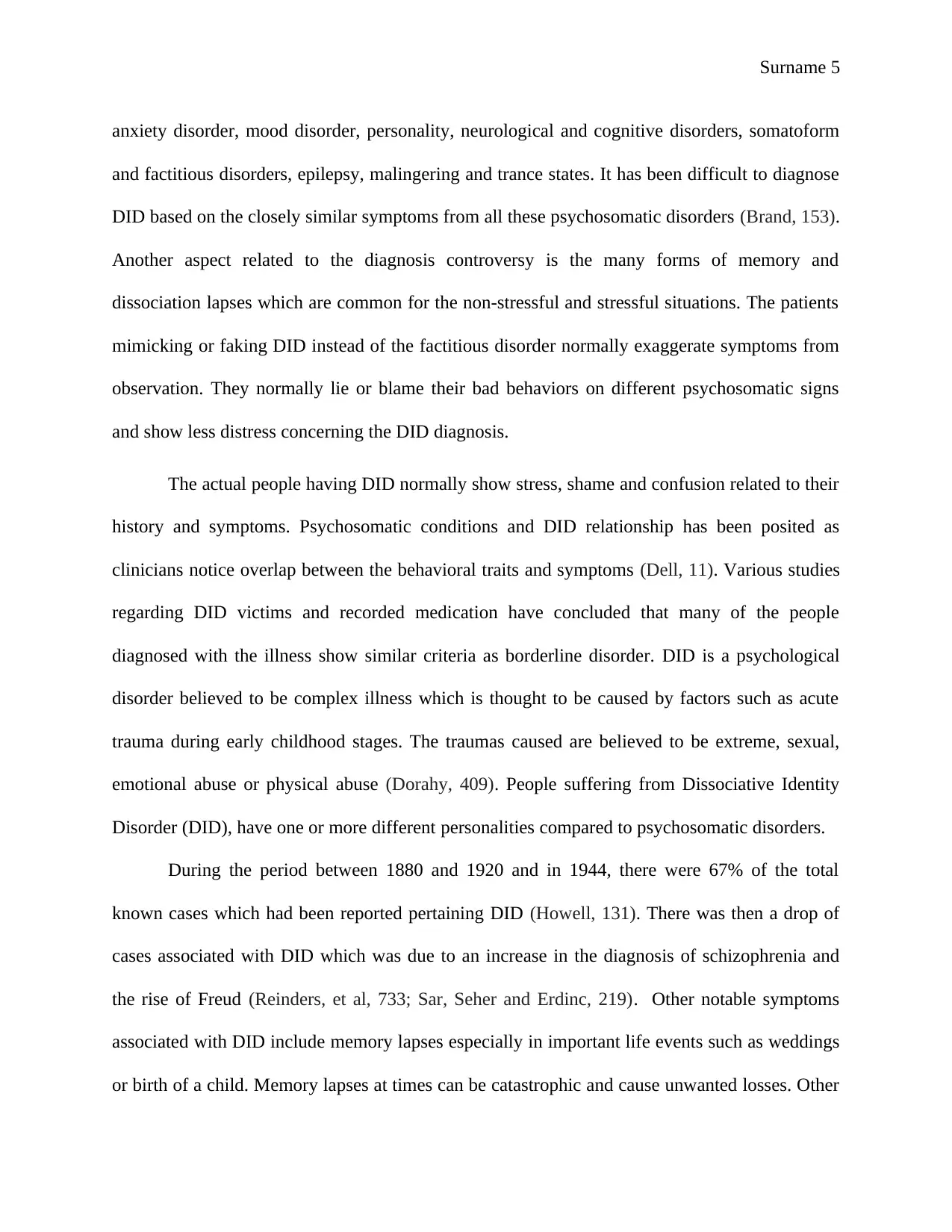
Surname 5
anxiety disorder, mood disorder, personality, neurological and cognitive disorders, somatoform
and factitious disorders, epilepsy, malingering and trance states. It has been difficult to diagnose
DID based on the closely similar symptoms from all these psychosomatic disorders (Brand, 153).
Another aspect related to the diagnosis controversy is the many forms of memory and
dissociation lapses which are common for the non-stressful and stressful situations. The patients
mimicking or faking DID instead of the factitious disorder normally exaggerate symptoms from
observation. They normally lie or blame their bad behaviors on different psychosomatic signs
and show less distress concerning the DID diagnosis.
The actual people having DID normally show stress, shame and confusion related to their
history and symptoms. Psychosomatic conditions and DID relationship has been posited as
clinicians notice overlap between the behavioral traits and symptoms (Dell, 11). Various studies
regarding DID victims and recorded medication have concluded that many of the people
diagnosed with the illness show similar criteria as borderline disorder. DID is a psychological
disorder believed to be complex illness which is thought to be caused by factors such as acute
trauma during early childhood stages. The traumas caused are believed to be extreme, sexual,
emotional abuse or physical abuse (Dorahy, 409). People suffering from Dissociative Identity
Disorder (DID), have one or more different personalities compared to psychosomatic disorders.
During the period between 1880 and 1920 and in 1944, there were 67% of the total
known cases which had been reported pertaining DID (Howell, 131). There was then a drop of
cases associated with DID which was due to an increase in the diagnosis of schizophrenia and
the rise of Freud (Reinders, et al, 733; Sar, Seher and Erdinc, 219). Other notable symptoms
associated with DID include memory lapses especially in important life events such as weddings
or birth of a child. Memory lapses at times can be catastrophic and cause unwanted losses. Other
anxiety disorder, mood disorder, personality, neurological and cognitive disorders, somatoform
and factitious disorders, epilepsy, malingering and trance states. It has been difficult to diagnose
DID based on the closely similar symptoms from all these psychosomatic disorders (Brand, 153).
Another aspect related to the diagnosis controversy is the many forms of memory and
dissociation lapses which are common for the non-stressful and stressful situations. The patients
mimicking or faking DID instead of the factitious disorder normally exaggerate symptoms from
observation. They normally lie or blame their bad behaviors on different psychosomatic signs
and show less distress concerning the DID diagnosis.
The actual people having DID normally show stress, shame and confusion related to their
history and symptoms. Psychosomatic conditions and DID relationship has been posited as
clinicians notice overlap between the behavioral traits and symptoms (Dell, 11). Various studies
regarding DID victims and recorded medication have concluded that many of the people
diagnosed with the illness show similar criteria as borderline disorder. DID is a psychological
disorder believed to be complex illness which is thought to be caused by factors such as acute
trauma during early childhood stages. The traumas caused are believed to be extreme, sexual,
emotional abuse or physical abuse (Dorahy, 409). People suffering from Dissociative Identity
Disorder (DID), have one or more different personalities compared to psychosomatic disorders.
During the period between 1880 and 1920 and in 1944, there were 67% of the total
known cases which had been reported pertaining DID (Howell, 131). There was then a drop of
cases associated with DID which was due to an increase in the diagnosis of schizophrenia and
the rise of Freud (Reinders, et al, 733; Sar, Seher and Erdinc, 219). Other notable symptoms
associated with DID include memory lapses especially in important life events such as weddings
or birth of a child. Memory lapses at times can be catastrophic and cause unwanted losses. Other
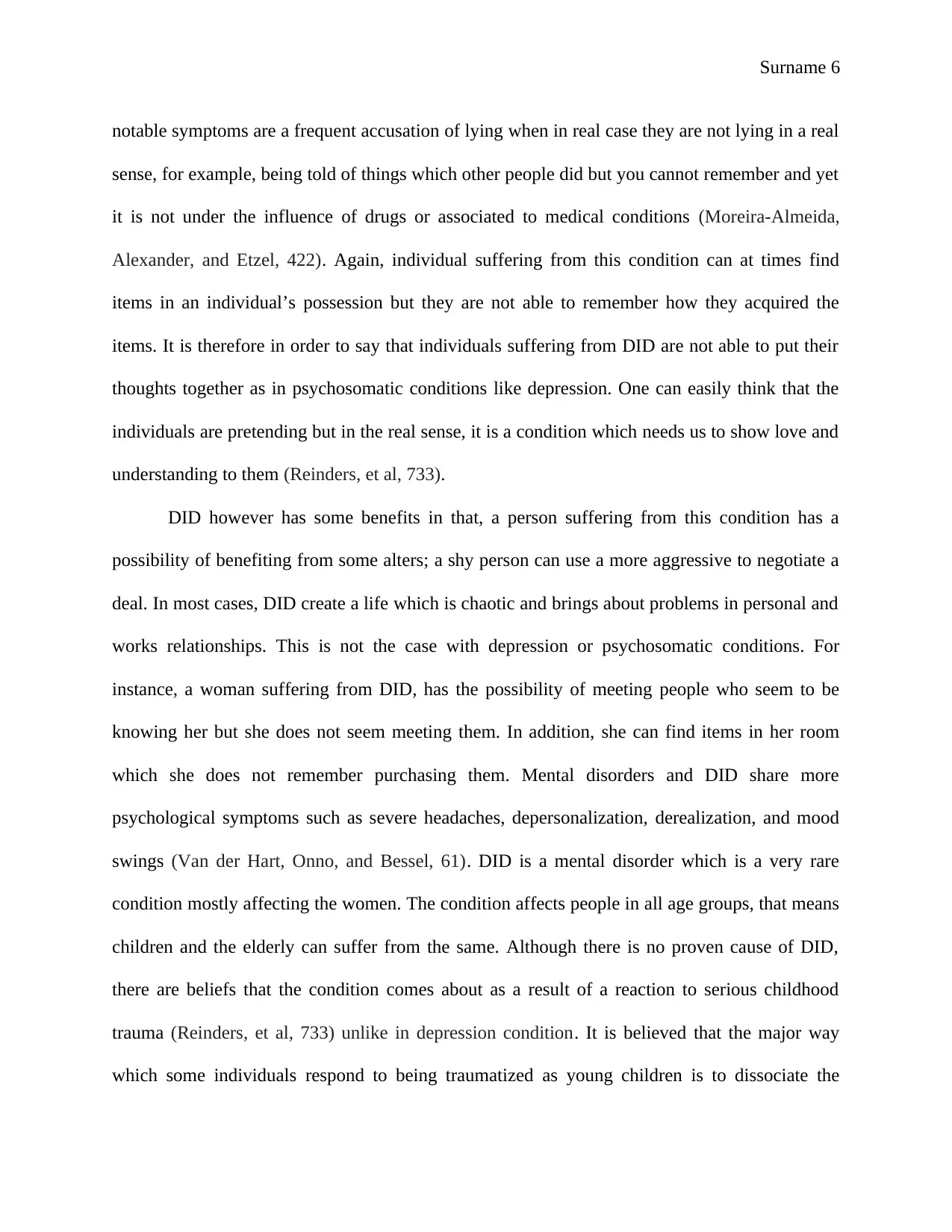
Surname 6
notable symptoms are a frequent accusation of lying when in real case they are not lying in a real
sense, for example, being told of things which other people did but you cannot remember and yet
it is not under the influence of drugs or associated to medical conditions (Moreira-Almeida,
Alexander, and Etzel, 422). Again, individual suffering from this condition can at times find
items in an individual’s possession but they are not able to remember how they acquired the
items. It is therefore in order to say that individuals suffering from DID are not able to put their
thoughts together as in psychosomatic conditions like depression. One can easily think that the
individuals are pretending but in the real sense, it is a condition which needs us to show love and
understanding to them (Reinders, et al, 733).
DID however has some benefits in that, a person suffering from this condition has a
possibility of benefiting from some alters; a shy person can use a more aggressive to negotiate a
deal. In most cases, DID create a life which is chaotic and brings about problems in personal and
works relationships. This is not the case with depression or psychosomatic conditions. For
instance, a woman suffering from DID, has the possibility of meeting people who seem to be
knowing her but she does not seem meeting them. In addition, she can find items in her room
which she does not remember purchasing them. Mental disorders and DID share more
psychological symptoms such as severe headaches, depersonalization, derealization, and mood
swings (Van der Hart, Onno, and Bessel, 61). DID is a mental disorder which is a very rare
condition mostly affecting the women. The condition affects people in all age groups, that means
children and the elderly can suffer from the same. Although there is no proven cause of DID,
there are beliefs that the condition comes about as a result of a reaction to serious childhood
trauma (Reinders, et al, 733) unlike in depression condition. It is believed that the major way
which some individuals respond to being traumatized as young children is to dissociate the
notable symptoms are a frequent accusation of lying when in real case they are not lying in a real
sense, for example, being told of things which other people did but you cannot remember and yet
it is not under the influence of drugs or associated to medical conditions (Moreira-Almeida,
Alexander, and Etzel, 422). Again, individual suffering from this condition can at times find
items in an individual’s possession but they are not able to remember how they acquired the
items. It is therefore in order to say that individuals suffering from DID are not able to put their
thoughts together as in psychosomatic conditions like depression. One can easily think that the
individuals are pretending but in the real sense, it is a condition which needs us to show love and
understanding to them (Reinders, et al, 733).
DID however has some benefits in that, a person suffering from this condition has a
possibility of benefiting from some alters; a shy person can use a more aggressive to negotiate a
deal. In most cases, DID create a life which is chaotic and brings about problems in personal and
works relationships. This is not the case with depression or psychosomatic conditions. For
instance, a woman suffering from DID, has the possibility of meeting people who seem to be
knowing her but she does not seem meeting them. In addition, she can find items in her room
which she does not remember purchasing them. Mental disorders and DID share more
psychological symptoms such as severe headaches, depersonalization, derealization, and mood
swings (Van der Hart, Onno, and Bessel, 61). DID is a mental disorder which is a very rare
condition mostly affecting the women. The condition affects people in all age groups, that means
children and the elderly can suffer from the same. Although there is no proven cause of DID,
there are beliefs that the condition comes about as a result of a reaction to serious childhood
trauma (Reinders, et al, 733) unlike in depression condition. It is believed that the major way
which some individuals respond to being traumatized as young children is to dissociate the
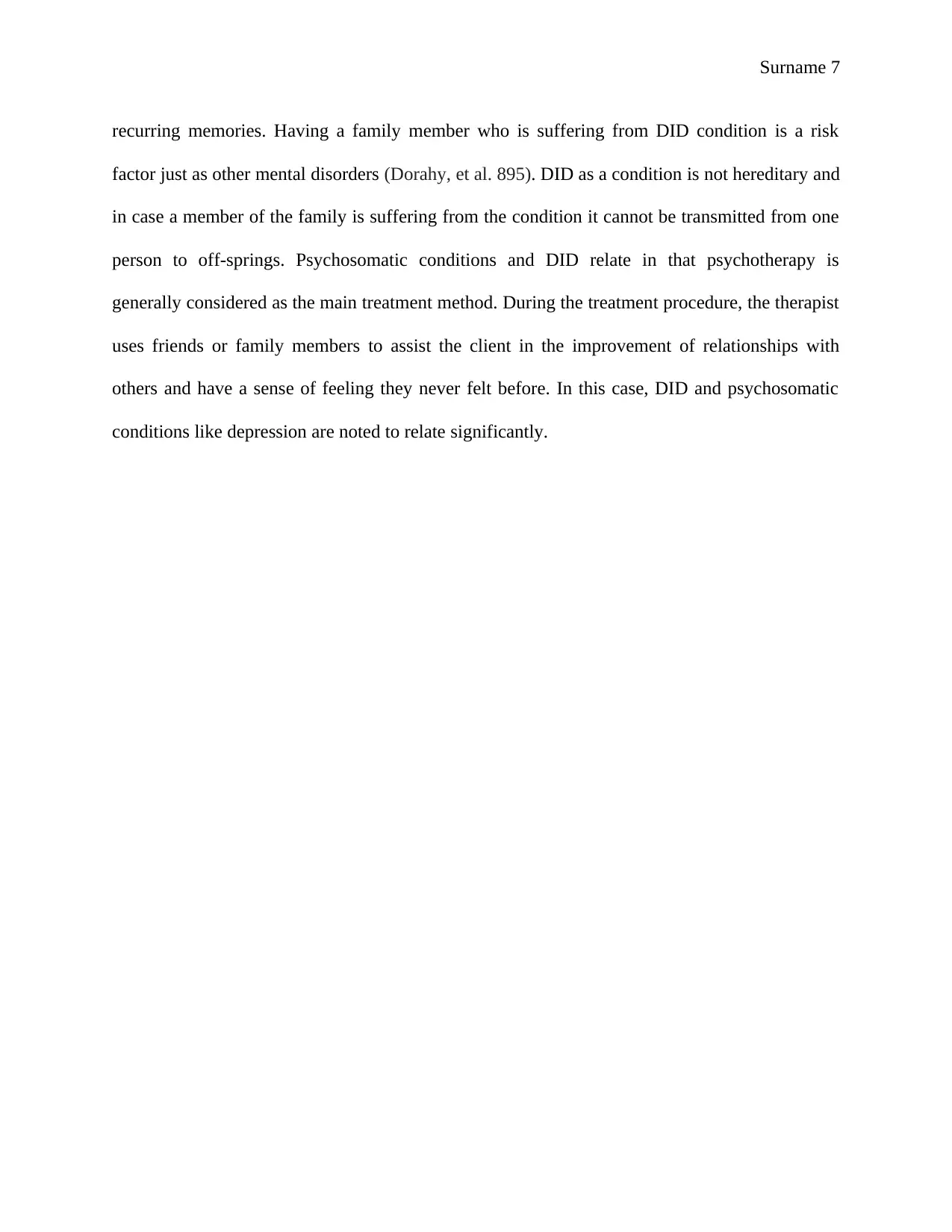
Surname 7
recurring memories. Having a family member who is suffering from DID condition is a risk
factor just as other mental disorders (Dorahy, et al. 895). DID as a condition is not hereditary and
in case a member of the family is suffering from the condition it cannot be transmitted from one
person to off-springs. Psychosomatic conditions and DID relate in that psychotherapy is
generally considered as the main treatment method. During the treatment procedure, the therapist
uses friends or family members to assist the client in the improvement of relationships with
others and have a sense of feeling they never felt before. In this case, DID and psychosomatic
conditions like depression are noted to relate significantly.
recurring memories. Having a family member who is suffering from DID condition is a risk
factor just as other mental disorders (Dorahy, et al. 895). DID as a condition is not hereditary and
in case a member of the family is suffering from the condition it cannot be transmitted from one
person to off-springs. Psychosomatic conditions and DID relate in that psychotherapy is
generally considered as the main treatment method. During the treatment procedure, the therapist
uses friends or family members to assist the client in the improvement of relationships with
others and have a sense of feeling they never felt before. In this case, DID and psychosomatic
conditions like depression are noted to relate significantly.
Paraphrase This Document
Need a fresh take? Get an instant paraphrase of this document with our AI Paraphraser
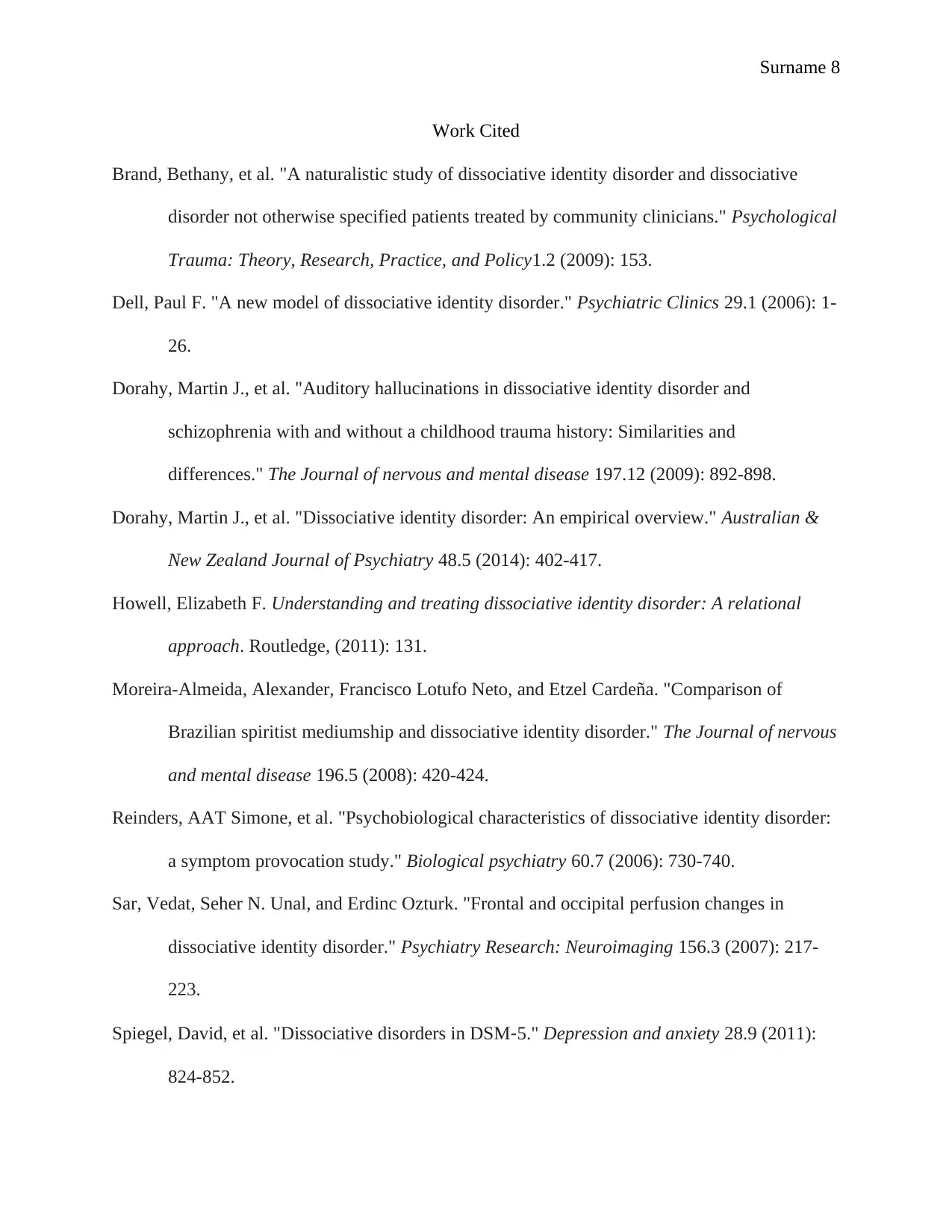
Surname 8
Work Cited
Brand, Bethany, et al. "A naturalistic study of dissociative identity disorder and dissociative
disorder not otherwise specified patients treated by community clinicians." Psychological
Trauma: Theory, Research, Practice, and Policy1.2 (2009): 153.
Dell, Paul F. "A new model of dissociative identity disorder." Psychiatric Clinics 29.1 (2006): 1-
26.
Dorahy, Martin J., et al. "Auditory hallucinations in dissociative identity disorder and
schizophrenia with and without a childhood trauma history: Similarities and
differences." The Journal of nervous and mental disease 197.12 (2009): 892-898.
Dorahy, Martin J., et al. "Dissociative identity disorder: An empirical overview." Australian &
New Zealand Journal of Psychiatry 48.5 (2014): 402-417.
Howell, Elizabeth F. Understanding and treating dissociative identity disorder: A relational
approach. Routledge, (2011): 131.
Moreira-Almeida, Alexander, Francisco Lotufo Neto, and Etzel Cardeña. "Comparison of
Brazilian spiritist mediumship and dissociative identity disorder." The Journal of nervous
and mental disease 196.5 (2008): 420-424.
Reinders, AAT Simone, et al. "Psychobiological characteristics of dissociative identity disorder:
a symptom provocation study." Biological psychiatry 60.7 (2006): 730-740.
Sar, Vedat, Seher N. Unal, and Erdinc Ozturk. "Frontal and occipital perfusion changes in
dissociative identity disorder." Psychiatry Research: Neuroimaging 156.3 (2007): 217-
223.
Spiegel, David, et al. "Dissociative disorders in DSM‐5." Depression and anxiety 28.9 (2011):
824-852.
Work Cited
Brand, Bethany, et al. "A naturalistic study of dissociative identity disorder and dissociative
disorder not otherwise specified patients treated by community clinicians." Psychological
Trauma: Theory, Research, Practice, and Policy1.2 (2009): 153.
Dell, Paul F. "A new model of dissociative identity disorder." Psychiatric Clinics 29.1 (2006): 1-
26.
Dorahy, Martin J., et al. "Auditory hallucinations in dissociative identity disorder and
schizophrenia with and without a childhood trauma history: Similarities and
differences." The Journal of nervous and mental disease 197.12 (2009): 892-898.
Dorahy, Martin J., et al. "Dissociative identity disorder: An empirical overview." Australian &
New Zealand Journal of Psychiatry 48.5 (2014): 402-417.
Howell, Elizabeth F. Understanding and treating dissociative identity disorder: A relational
approach. Routledge, (2011): 131.
Moreira-Almeida, Alexander, Francisco Lotufo Neto, and Etzel Cardeña. "Comparison of
Brazilian spiritist mediumship and dissociative identity disorder." The Journal of nervous
and mental disease 196.5 (2008): 420-424.
Reinders, AAT Simone, et al. "Psychobiological characteristics of dissociative identity disorder:
a symptom provocation study." Biological psychiatry 60.7 (2006): 730-740.
Sar, Vedat, Seher N. Unal, and Erdinc Ozturk. "Frontal and occipital perfusion changes in
dissociative identity disorder." Psychiatry Research: Neuroimaging 156.3 (2007): 217-
223.
Spiegel, David, et al. "Dissociative disorders in DSM‐5." Depression and anxiety 28.9 (2011):
824-852.

Surname 9
Van der Hart, Onno, Hilde Bolt, and Bessel A. Van Der Kolk. "Memory fragmentation in
dissociative identity disorder." Journal of Trauma & Dissociation 6.1 (2005): 55-70.
Van der Hart, Onno, Hilde Bolt, and Bessel A. Van Der Kolk. "Memory fragmentation in
dissociative identity disorder." Journal of Trauma & Dissociation 6.1 (2005): 55-70.
1 out of 9
Related Documents
Your All-in-One AI-Powered Toolkit for Academic Success.
+13062052269
info@desklib.com
Available 24*7 on WhatsApp / Email
![[object Object]](/_next/static/media/star-bottom.7253800d.svg)
Unlock your academic potential
© 2024 | Zucol Services PVT LTD | All rights reserved.





